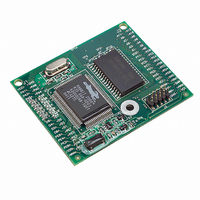20-101-0383 Rabbit Semiconductor, 20-101-0383 Datasheet - Page 32

20-101-0383
Manufacturer Part Number
20-101-0383
Description
MODULE RABBITCORE RCM2020
Manufacturer
Rabbit Semiconductor
Datasheet
1.20-101-0383.pdf
(80 pages)
Specifications of 20-101-0383
Module/board Type
MPU Core Module
Product
Microcontroller Modules
Core Processor
Rabbit 2000
Clock Speed
18.432 MHz
Interface Type
Ethernet, Serial
Flash
256 KB
Timers
5 x 8 bit, 2 x 10 bit
Operating Supply Voltage
4.75 V to 5.25 V
Board Size
48.3 mm x 58.4 mm x 14 mm
Core
RCM2020
Processor Series
RCM2000
For Use With/related Products
RCM2020
Lead Free Status / RoHS Status
Lead free / RoHS Compliant
Other names
316-1082
4.2 Memory I/O Interface
Thirteen of the Rabbit 2000 address lines (A0–A12) and all the data lines (D0–D7) are
available as outputs on the RCM2000. I/0 write (/IOWR), I/0 read (/IORD), buffer enable
(/BUFEN), and Watchdog Output (/WDO) are also available for interfacing to external
devices.
The STATUS output has three different programmable functions:
1. It can be driven low on the first op code fetch cycle.
2. It can be driven low during an interrupt acknowledge cycle.
3. It can also serve as a general-purpose output.
4.2.1 Additional I/0
Although, the output clock is available on the PCLK pin, the output clock is disabled in
software starting with Dynamic C v 7.02 and later. This reduces radiated emissions. The
primary function of PCLK is as a peripheral clock or a peripheral clock ÷ 2, but PCLK can
instead be used as a digital output. See Section 5.2.1, “PCLK Output,” for more informa-
tion.
Two status mode pins, SMODE0 and SMODE1, are available as inputs. The logic state of
these two pins determines the startup procedure after a reset. /RES_IN is an external input
used to reset the Rabbit 2000 microprocessor and RCM2000 memory. /RES_OUT is an
output from the reset circuitry that can be used to reset other peripheral devices.
4.3 Serial Communication
The RCM2000 does not have an RS-232 or an RS-485 transceiver directly on the board.
However, the Prototyping Board does support a industry standard RS-232 transceiver
chip. See Appendix B, “Prototyping Board,” for more information.
4.3.1 Serial Ports
There are four serial ports designated as Serial Ports A, B, C, and D. All four serial ports
can operate in an asynchronous mode up to the baud rate of the system clock divided by
32. An asynchronous port can handle 7 or 8 data bits. A 9th bit address scheme, where an
additional bit is sent to mark the first byte of a message, is also supported. Serial Ports A
and B can be operated alternately in the clocked serial mode. In this mode, a clock line
synchronously clocks the data in or out. Either of the two communicating devices can sup-
ply the clock. When the Rabbit provides the clock, the baud rate can be up to 1/4 of the
system clock frequency, or more than 6.45 Mbps for a 25.8 MHz clock speed.
28
RabbitCore RCM2000

















